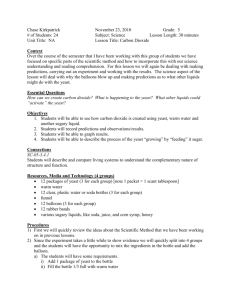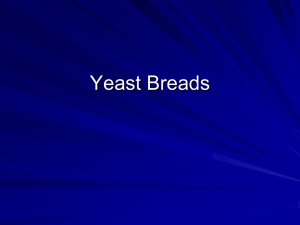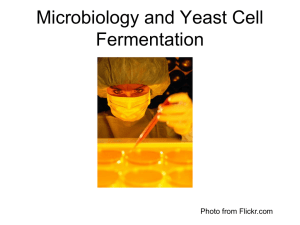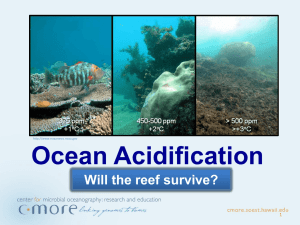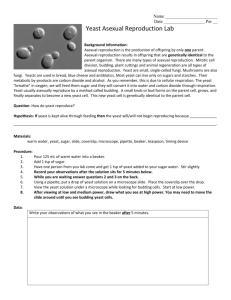CELLULAR RESPIRATION LAB Student directions: In this lab, you
advertisement
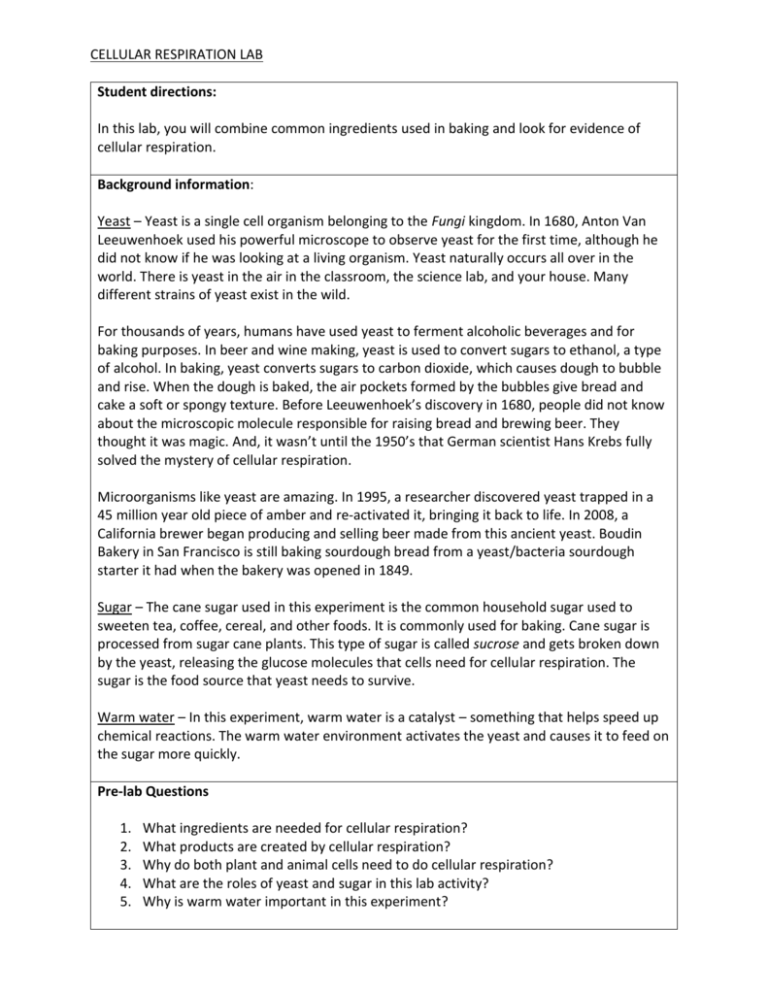
CELLULAR RESPIRATION LAB Student directions: In this lab, you will combine common ingredients used in baking and look for evidence of cellular respiration. Background information: Yeast – Yeast is a single cell organism belonging to the Fungi kingdom. In 1680, Anton Van Leeuwenhoek used his powerful microscope to observe yeast for the first time, although he did not know if he was looking at a living organism. Yeast naturally occurs all over in the world. There is yeast in the air in the classroom, the science lab, and your house. Many different strains of yeast exist in the wild. For thousands of years, humans have used yeast to ferment alcoholic beverages and for baking purposes. In beer and wine making, yeast is used to convert sugars to ethanol, a type of alcohol. In baking, yeast converts sugars to carbon dioxide, which causes dough to bubble and rise. When the dough is baked, the air pockets formed by the bubbles give bread and cake a soft or spongy texture. Before Leeuwenhoek’s discovery in 1680, people did not know about the microscopic molecule responsible for raising bread and brewing beer. They thought it was magic. And, it wasn’t until the 1950’s that German scientist Hans Krebs fully solved the mystery of cellular respiration. Microorganisms like yeast are amazing. In 1995, a researcher discovered yeast trapped in a 45 million year old piece of amber and re-activated it, bringing it back to life. In 2008, a California brewer began producing and selling beer made from this ancient yeast. Boudin Bakery in San Francisco is still baking sourdough bread from a yeast/bacteria sourdough starter it had when the bakery was opened in 1849. Sugar – The cane sugar used in this experiment is the common household sugar used to sweeten tea, coffee, cereal, and other foods. It is commonly used for baking. Cane sugar is processed from sugar cane plants. This type of sugar is called sucrose and gets broken down by the yeast, releasing the glucose molecules that cells need for cellular respiration. The sugar is the food source that yeast needs to survive. Warm water – In this experiment, warm water is a catalyst – something that helps speed up chemical reactions. The warm water environment activates the yeast and causes it to feed on the sugar more quickly. Pre-lab Questions 1. 2. 3. 4. 5. What ingredients are needed for cellular respiration? What products are created by cellular respiration? Why do both plant and animal cells need to do cellular respiration? What are the roles of yeast and sugar in this lab activity? Why is warm water important in this experiment? Lab Procedure You will need the following supplies: - 1 empty water bottle - Measuring spoon (teaspoon size) - 1 balloon - 1 teaspoon of dry yeast - 2 teaspoons of sugar - 150 ml of water warmed to 110 degrees F - 200 ml glass beaker - Clear plastic tub - Plastic ruler - Stopwatch - Ribbon tape that measures cm - Thermometer 1. 2. 3. 4. 5. 6. 7. 8. Pour 150 ml of water into a 200 ml beaker Using a hot plate on the setting ‘5’, warm the water in the beaker to 110 degrees F Fill a clear plastic tub with 1” of warm tap water Carefully pour the warmed water from the beaker into the water bottle Add 2 teaspoons of sugar to the water bottle Add 1 teaspoon of yeast to the water bottle Shake/stir the water bottle to completely dissolve the yeast/sugar mixture Quickly place a balloon over the top of the water bottle and place the bottle in the clear tub of warm tap water 9. Start the stopwatch and make observations at 5 minutes, 10 minutes and 15 minutes. Re-create the table below on your lab sheet: Time Qualitative description (What do you see happening in the balloon and the bottle?) Quantitative description (Measure around the balloon in cm) Quantitative description (Measure the height of the foam layer on top of the liquid in cm) 5 min 10 min 15 min 10. After the 15 minute observation, wash all liquids down the sink, throw away the balloon, and place your water bottle in the recycling bin. 11. Complete the post-lab questions. Post-lab Questions 1. 2. 3. 4. When the yeast consumed sugar, what products were created? What types of evidence in the lab activity showed that cellular respiration took place? What do you think would have happened if the sample remained set up overnight? How would our world be different if humans did not discover how to use yeast thousands of years ago?



